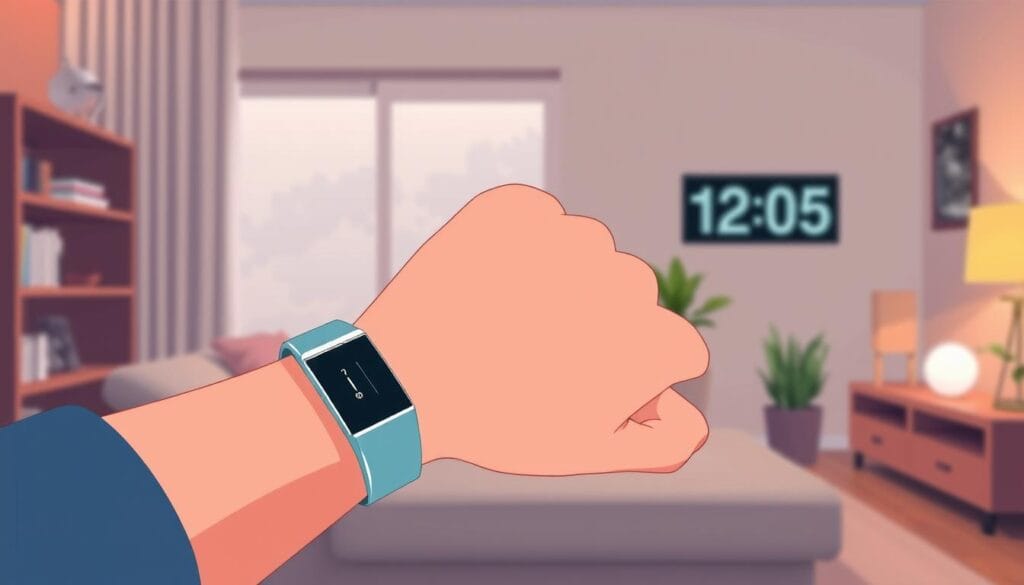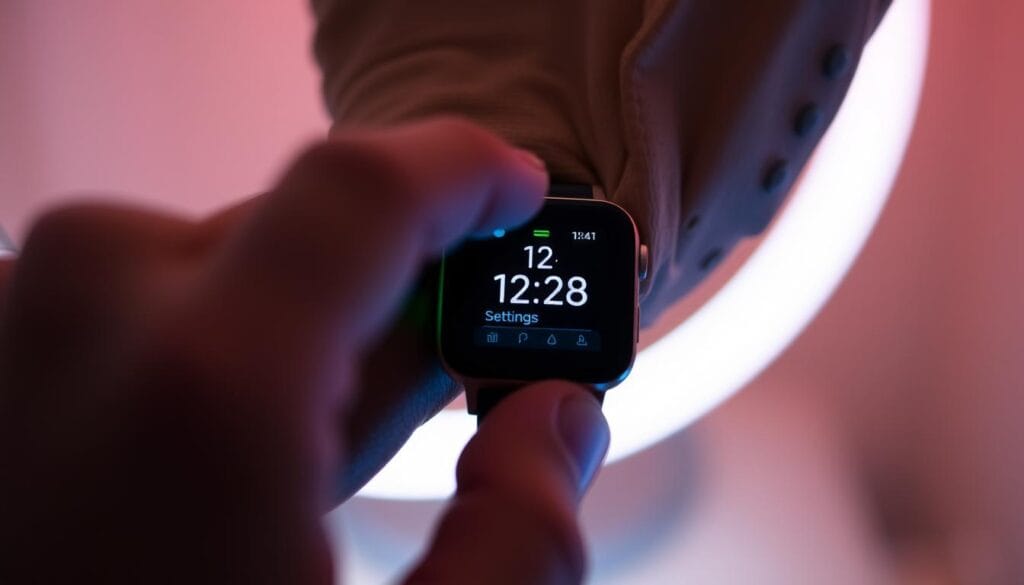Table of Contents
Do you need to know how to change time on Fitbit? Technology is now a big part of our lives, making it key to track time well. For Fitbit users, it’s a personal time-keeper for daily activities and sleep. But, what if your Fitbit’s time is wrong? It can mess up your day, making you feel off-beat.
In this guide, I’ll show you how to keep your Fitbit’s time right. This way, you can stay focused on your fitness goals without worry.

Key Takeaways
- Understand the importance of accurate time on your Fitbit device
- Explore the different time display options available for Fitbit
- Learn how to change the time on your Fitbit through the mobile app
- Discover how to sync your Fitbit’s time automatically and troubleshoot any issues
- Manage daylight saving time changes with ease
Understanding Your Fitbit Time Settings
Having the right time on your Fitbit is key for tracking your activities, sleep, and heart rate. It’s important for understanding the data your Fitbit collects. We’ll look at why time settings matter, the display options, and common issues.
Why Accurate Time Matters on Your Fitbit
Your Fitbit’s time affects the accuracy of its data. If the time is wrong, your activity and sleep data won’t be right. This makes it hard to track your progress and reach your health goals. Keeping the right time ensures your data is accurate, helping you see your daily and long-term trends clearly.
Different Time Display Options Available
Fitbit devices let you choose how you see the time. You can pick between a 12-hour or 24-hour clock. Some models even let you switch between digital and analog clock faces. Knowing these options helps you customize your Fitbit and read the time easily.
Common Time-Related Issues
Even though Fitbits usually keep the right time, sometimes issues arise. These can include wrong time display, time zone problems, or trouble syncing with the app. We’ll give you tips and advice to fix these problems.
By knowing about Fitbit time settings and options, you can make sure your device tracks your activities well. This gives you reliable data to help you reach your health and fitness goals. Next, we’ll show you how to change your Fitbit’s time using the mobile app.
| Time Display Options | Description |
|---|---|
| 12-hour format | Displays the time in a 12-hour clock, with AM and PM indicators. |
| 24-hour format | Displays the time in a 24-hour clock, from 00:00 to 23:59. |
| Digital clock face | Shows the time in a numerical digital display. |
| Analog clock face | Displays the time using a traditional analog clock face with hands. |
How to Change Time on Fitbit Through the App
Changing the time on your Fitbit is easy and can be done through the Fitbit app. It works the same on both iOS and Android devices. Here’s how to change time on fitbit and update fitbit time through the app.
Changing Time on Fitbit: iOS
Here’s what to do on an iOS device to update your Fitbit’s time:
- Open the Fitbit app on your iPhone or iPad.
- Tap on the “Today” tab at the bottom of the screen.
- Tap on your profile picture or the gear icon in the top-right corner.
- Select “App Settings”.
- Scroll down to the “Time” section and tap on “Time Zone”.
- Toggle the “Automatic” setting to “Off”.
- Manually adjust the time and time zone to your desired settings.
- Tap “Done” to save the changes.
Changing Time on Fitbit: Android
For Android devices, the steps are similar:
- Open the Fitbit app on your Android smartphone or tablet.
- Tap on the “Today” tab at the bottom of the screen.
- Tap on your profile picture or the gear icon in the top-right corner.
- Select “App Settings”.
- Scroll down to the “Time” section and tap on “Time Zone”.
- Toggle the “Automatic” setting to “Off”.
- Manually adjust the time and time zone to your desired settings.
- Tap “Save” to apply the changes.
If you have trouble changing the time on your Fitbit through the app, check the user manual. Or, reach out to Fitbit’s customer support for help.
Syncing Your Fitbit Time Automatically
Fitbit devices can automatically sync your time. This keeps your device accurate and in sync with your time zone. It’s important for tracking your activity, sleep, and health metrics.
Understanding Time Zone Settings
To use auto-sync, make sure your Fitbit has the right time zone. You can set this up in the Fitbit app or on their website. Keeping your fitbit time zone current means your device will adjust time as you travel. You won’t need to change it manually.
Troubleshooting Sync Issues
While syncing is usually smooth, you might face issues. These could be due to connectivity, device compatibility, or other reasons. If you run into problems, check the Fitbit troubleshooting guides or contact their support team.
Best Practices for Auto-Sync
- Make sure your Fitbit is connected to the internet or your mobile via Bluetooth for auto-sync.
- Regularly check and update your time zone settings to keep time tracking accurate.
- If you have sync problems, try restarting your device or fix the connection between your Fitbit and the app or website.
- Enable location services on your mobile to let your Fitbit adjust to your time zone as you travel.
Using your Fitbit’s auto-sync feature lets you track time smoothly. It makes your fitness tracker more reliable and convenient.

Manual Time Adjustment Methods
Fitbit devices usually sync time automatically. But sometimes, you might need to set fitbit time manually or adjust fitbit clock. This guide will show you how to manually update your Fitbit’s time.
Let’s talk about when you might need to adjust the time yourself. If you’re traveling to a new time zone and your Fitbit doesn’t update, you’ll have to set fitbit time manually. This is key for tracking your activities and sleep right.
- To set fitbit time manually on your tracker, follow these steps:
- Find the settings menu on your Fitbit.
- Go to the “Time” or “Clock” section.
- Change the time to what you want.
- Save it, and your Fitbit will show the new time.
- For Fitbit smartwatches, it’s almost the same:
- Open the Settings app on your watch.
- Tap on “Time” or “Date & Time”.
- Set fitbit time manually by changing the hour and minute.
- Confirm it, and your smartwatch will show the right time.
Remember, you might need to adjust the time on your Fitbit manually sometimes. This is when automatic syncing doesn’t work. By taking a little time to set fitbit time manually or adjust fitbit clock, you keep your device up to date. This helps you track your fitness and wellness goals better.

Managing Daylight Saving Time Updates
Keeping your Fitbit device’s time accurate is key, especially with Daylight Saving Time (DST) changes. Fitbit has features to make these updates easy.
Automatic DST Adjustment Features
Fitbit can automatically update your device’s time when DST starts and ends. This keeps your Fitbit’s clock in sync with local time, so you don’t have to adjust it manually. Just make sure your time zone settings are right, and Fitbit will take care of the rest.
Manual DST Override Options
Even with automatic updates, sometimes you might need to change the time on your Fitbit yourself. This could be because of time zone issues or other reasons. Luckily, Fitbit’s mobile app makes it simple to change your device’s time.
Regional Time Change Considerations
Remember, DST rules can differ by area. Places like Arizona and Hawaii in the U.S. don’t follow DST. If you live in these areas or have a Fitbit user who does, you’ll need to adjust the time yourself for accurate tracking.
| Feature | Description |
|---|---|
| Automatic DST Adjustment | Fitbit devices automatically update the time when Daylight Saving Time begins and ends, ensuring accurate time tracking. |
| Manual Time Adjustment | Users can manually change the time on their Fitbit devices through the mobile app if needed. |
| Regional Time Change Considerations | Some regions, such as Arizona and Hawaii, do not observe Daylight Saving Time, requiring manual time adjustments. |
Knowing how to use Fitbit’s time management features helps users keep their devices up to date. This ensures they handle Daylight Saving Time changes smoothly.
Conclusion
Managing your Fitbit’s time settings is easy and keeps your tracking accurate. You can use the Fitbit app, automatic sync, or manual adjustments. This guide helps you handle time changes, like daylight saving time or switching zones.
Having the right time on your Fitbit is key for good fitness tracking and sleep monitoring. By following this guide, you can update your Fitbit’s time easily. This keeps your fitness journey on track.
Your Fitbit’s time settings are crucial for getting the most out of it. Learning how to manage time on your Fitbit helps you stay motivated. It’s a step towards a healthier, more active life.
FAQ
How do I change the time on my Fitbit device?
You can change your Fitbit’s time in several ways. You can use the Fitbit app, sync it to update automatically, or set it manually.
Why is it important to have the correct time on my Fitbit?
Having the right time is key for your Fitbit. It helps track your activities, sleep, and health metrics. This ensures your data is correct and you can review it accurately.
How do I update the time on my Fitbit using the mobile app?
To update your Fitbit’s time in the app, open it. Go to “Account,” select your device, and then tap “Time” to adjust the settings.
Can my Fitbit device automatically sync the time?
Yes, your Fitbit can sync the time automatically. Just make sure location services and time zone settings are on. This keeps your device’s time up to date.
How do I manually set the time on my Fitbit device?
To set the time manually, go to your device’s settings. Choose “Time,” then “Set Time.” Adjust the hour and minute as needed.
How does my Fitbit handle Daylight Saving Time changes?
Most Fitbits adjust for Daylight Saving Time (DST) automatically. They update the time by an hour when DST starts or ends. You can also change this setting manually if needed.
You can read more how-to guides by clicking here.
Or you can check out our apps on the Play Store:

